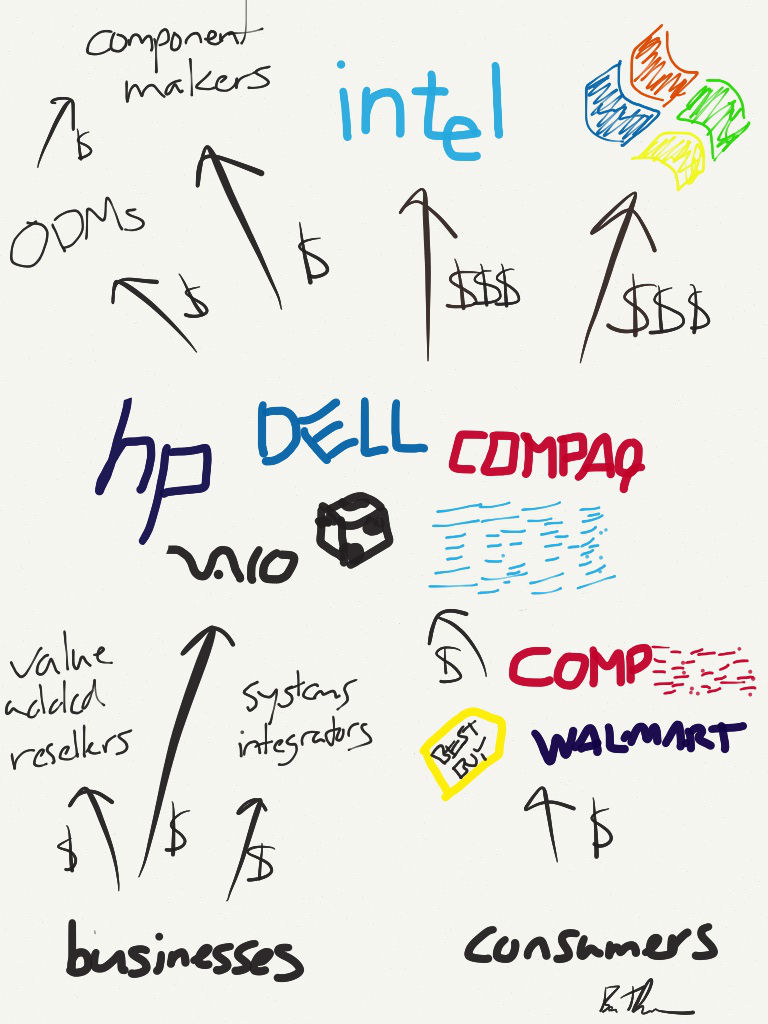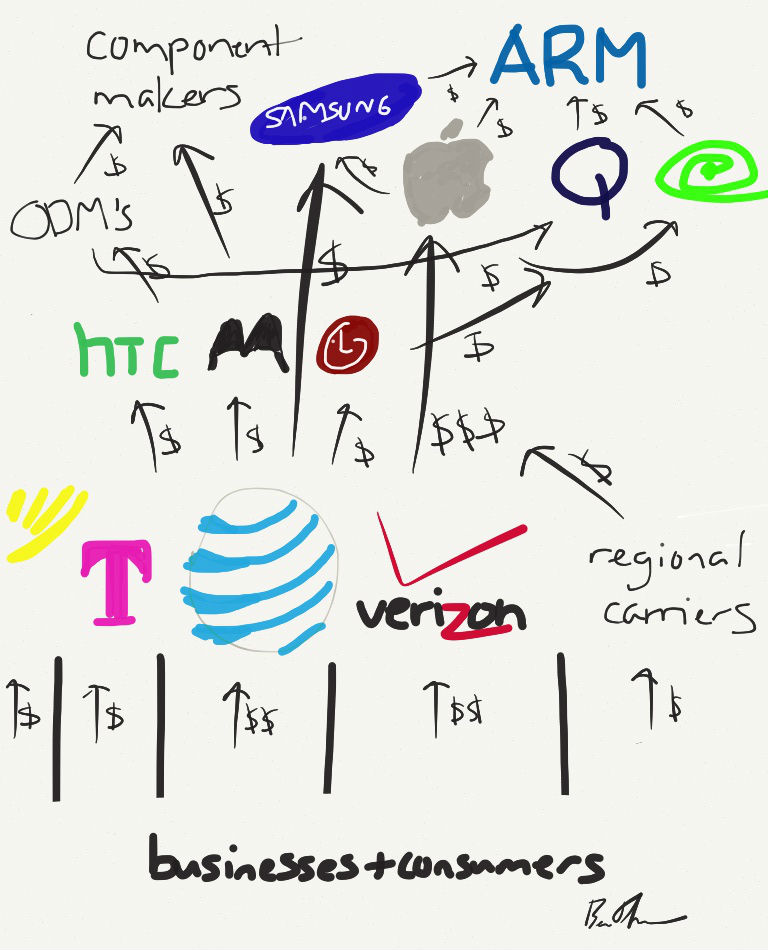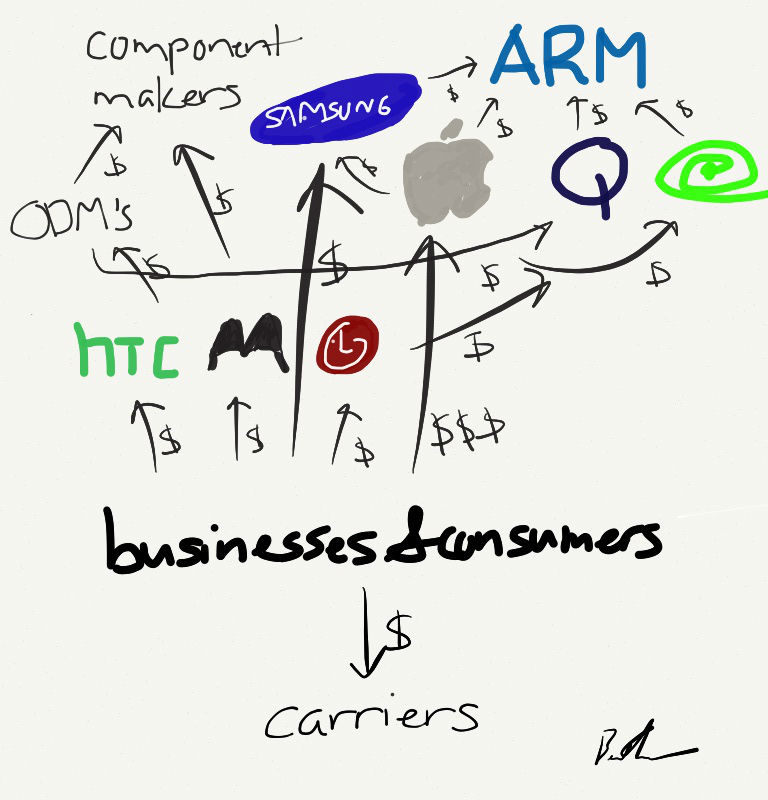Value Chains
Value Chains
The Samsung Galaxy 4 reviews should be rolling in shortly. They will recount the screen, processor, camera, face detection tech — every speed and feed there is will be dissected, discussed, and scored. Said features will be compared, first to the recently released HTC One, and most certainly to the iPhone 5. And most of it will have little to no use in explaining Samsung’s success. Speeds and feeds don’t matter in the mobile value chain.
But first a step back.
Value chains track the flow of money in an industry. Basically, who pays who. If there is a choice in whom to pay, you usually pay less. If you only have one choice, or if switching costs are high, you pay a lot more.
Much of the tech blogosphere came of age in the PC era. The PC value chain is relatively straightforward:

Nearly every part of the PC value chain was competitive. The exceptions were Intel 1 and Microsoft – and that is why those were two of the most valuable companies in the world. However – and this is critical – neither sold directly to customers. 2 It was the OEMs who owned the customer relationship, which, beyond forcing them to shoulder Microsoft’s support costs, left them with little to compete on beyond speeds and feeds. After all, all of the computers ran Windows, and they were fully compatible. 3 And so, meaningful comparisons between computers amounted to little more than arguments about speeds and feeds, and thus did a thousand gadget review sites bloom. 4
Not so in mobile, at least in the US.

Ignore the spaghetti at the top. Instead, observe how the carriers effectively block said spaghetti from consumers. It has been well documented that consumers in the US choose their carrier first, device second, which ultimately means speeds and feeds – the aforementioned spaghetti – don’t matter (I’ll preempt the objection now: yes, Apple is unique. But their approach and why it was effective can only be understood in the context of this value chain).
This makes the mobile market completely different from the PC market:
- PC buyers chose freely from every OEM; mobile buyers choose only from devices (and associated OEM’s) blessed by their carrier
- PC buyers are guaranteed compatibility no matter which PC they buy; mobile buyers have to first ensure their desired device works on their preferred carrier
- PC buyers purchase through multiple channels, including retail, value-added resellers, and direct, and pay full cost. Mobile buyers purchase subsidized phones that are sold through carriers
In short, carriers are the gatekeepers, and their revenue reflects that:

So read those S4 reviews with interest, but know that if they don’t account for the relationship between the manufacturer and carrier, and carrier and customer they are largely useless in the attempt to identify winners and losers.
Over the next few weeks I plan to dive into different parts of both of these value chains: the PC one, which is dying, and the mobile one, which is evolving. 5 And I haven’t forgotten the rest of the world; it looks a lot different: 6

One final note: you may have noticed that Google is nowhere to be found (except in the form of Motorola). That is because value chains track the flow of money; Android is (famously) free. 7
- Yes, AMD was nominally competitive, but only meaningfully so for a brief stretch around 2000. For all intents and purposes Intel was a monopoly — and priced accordingly. [ ↩ ]
- Microsoft sold boxed copies of Windows, but those only every accounted for a small percentage of its overall revenue. The vast majority of Windows revenue comes from the sale of new PCs. In other words, Windows has historically made most of its money from OEMs, not consumers. Yet another reason why the Surface was such a surprise. [ ↩ ]
- The history of the PC is an article I can not wait to write. So much – like widespread compatibility – was such a pure accident! [ ↩ ]
- Yes, I’ve ignored the Mac here. For one, it was largely ignorable, especially in 2000. Two, the way it fit in this value chain is quite interesting and gets at the heart of Microsoft v Apple [ ↩ ]
- T-Mobile’s announcement today was meaningful in this regard [ ↩ ]
- Yes, I’m missing China. [ ↩ ]
- If anything, I should include patent payments, but the drawings are complicated enough as it is! [ ↩ ]
文章版权归原作者所有。
